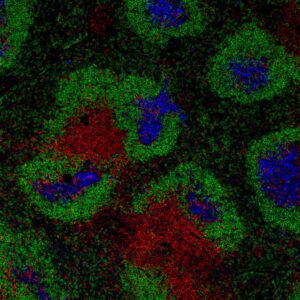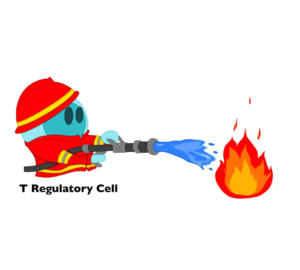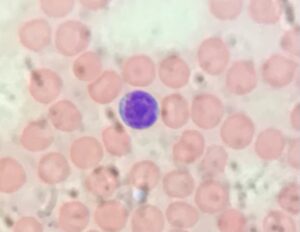Today I decided to present the role of the coolest immune cell of all. This cell has the ability to kill cells that are infected with virus or bacteria. Now that we already have a general idea of how an immune response works (recognize, remove, remember and repeat) I will start giving you some extra insights. The cell I will talk about today happens to be my favorite cell, but do not worry, I will make sure to talk about the other as well, so you can pick your favorite as we go.
As I mentioned in my previous post, as soon as you are infected with a pathogen (which is a microorganism that causes disease) your immune system will activated different mechanisms. It will put together many layers of defence to allow the recognition and removal of the threat. One of these layers is done by cytotoxic CD8 T cells. Don’t get too caught up on the hard words, cytotoxic just mean the ability of the cell to promote cellular death, or damage. You can also think about it as the killer T cell or just as the CD8 T cell! I hope you enjoy today’s post because next week I will feature a very special guest, which may or may not, also like CD8 T cells!
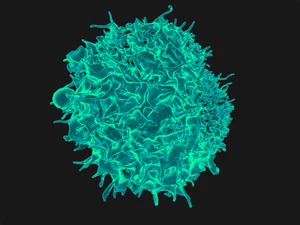
Colorized scanning electron micrograph of a T lymphocyte. Credit: NIAID
Virus, come on… you are not even alive!
Before we start talking about these cells, we have to understand what we want to kill. Viruses are composed of pretty much a genetic material (which again is the internal “recipe book”) and some proteins. These proteins will give the virus its structure and also provide it with some extra functions. There are many different viruses and each will carry different proteins depending on its need.
But what you have to remember is that viruses are not considered living entities, this is because it pretty much can’t do anything alone. The goal of a virus is very simple: to replicate! All it wants is to replicate and to infect other cells. But to do this, it requires some proteins that it does not have. Therefore the virus needs to find a home (a target cell) and use the proteins present in this cell to replicate. And this is where the problem lies. Because to do so, the virus prevents the target cell to do its natural job, and in many cases, this will cause us harm.
So, to kill the virus, we will use the CD8 T cells, which will target the home of the virus for degradation! Yes, our immune cell will target the infected cell, because if the virus doesn’t have a home, it can’t continue its replication cycle and therefore won’t infect other cells. So, the goal of the immune system in this scenario is to recognize the threat, activate the correct CD8 T cell which will find and kill the target cell. So let’s go step by step.
Hey, dendritic cell… go search!
The recognition will occur by the innate immune system (remember? our first line of defence). A specific cell type called the dendritic cell (or DC, for short) will recognize the threat (the infected cells) and it will acquire a little piece of the virus. Having this piece is essential, as this information will allow the dendritic cell to activate the correct CD8 T cell.
The dendritic cell will then travel to where many of our CD8 T cells are present (in the secondary lymphoid organs) and start the recognition process. If you remember from last week’s post, each T cell has a receptor (the TCR) that is very specific to a single pathogen. So the dendritic cell will present the piece of virus it has acquired at the site of infection to each CD8 T cell, until it finds the correct one (the T cell with the right specificity). The receptor is like a lock and the piece of the virus is like a key. The lock will only “open” if you have the correct key!
If you want to see the dendritic cell/ T cell interaction, check out the picture from this post!
Therefore, by carrying the information of the virus, the dendritic cells are able to activate the correct CD8 T cells even if these are present very far away from the infection site! The activation process is BEAUTIFUL and requires 3 signals, but I will keep this subject to a different post. Alright, CD8 T cell is activated, now what?
“Hasta la vista, baby!”
It would be pretty pointless to just bring a single specific CD8 T cell to the site of infection. Therefore, as soon the specific CD8 T cell is activated, it will undergo an expansion phase. Yes, the specific CD8 T cells will replicate… A LOT!! You want as much specific CD8 T cells as possible to deal with the problem, correct? But more than that, you want these cells to have a killing capacity. So, CD8 T cells will become effector cells, which will express proteins that are essential to kill the target cells.
You might be thinking, why would CD8 T cells wait for the activation to acquire effector functions? It is a great question! But imagine if all the CD8 T cells you have in your body right now were amazing killing machines? They could go crazy and start targeting your healthy cells for killing, and we REALLY don’t want that. So, only those that are activated will acquire the killing abilities.
Once the effector CD8 T cells are ready, they will move to the site of infection. And since these CD8 T cells have the receptor which is specific to the little piece of the virus, they can determine exactly which cell to target for killing. Infected cells will have the little piece of the virus on its surface, which will bind very specifically to the receptor on the T cell, and bang! Now the CD8 T cell knows that this is an infected cell (the target cell). Isn’t that just amazing?
CD8 T cells will then send proteins to the target cell to kill it. If all goes well, they will be able to remove all infected cells!
Now what? Picture this, your HIGH number of CD8 T cells with an amazing killing capacity present in your body, and the threat is gone. It sounds like a bad combination, right? Again, you never want very efficient activated killing machines going around if they have nothing to do.
“I’ll be back!”
So there will be another phase, which is called the contraction phase and it is marked by the death of 90-95% of all specific effector CD8 T cells. However, the survival of this 5-10% of cells is crucial! Our body is very skeptical and wants to be prepared for a secondary infection with the same pathogen if that ever happens.
Our immunological memory occurs because the 5-10% of effector cells that survive will become long live memory cells. You remember this, right? Now you have higher numbers of specific cells that are more efficient than your naive cells (those that have never seen the infection before).
Keep in mind that, although in this post I focused on explaining how CD8 T cells remove cells infected with viruses, a similar mechanism occurs when cells are infected with bacteria.
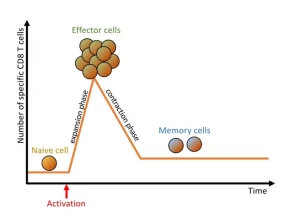
Graphical representation of CD8 T cell numbers following activation
There you go… We went from an infected cell to —> DC taking a little piece of the virus —> DC presenting this piece to the correct CD8 T cell at the secondary lymphoid organs —> the activation of the specific CD8 T cells —> replication and acquirement of CD8 T cell effector functions (expansion phase) —> migration to the site of infection —> target and killing of infected cells —> death of 90-95% of effectors cells (contraction phase) —> survival of 5-10% —> immunological memory. If this is not insanely beautiful, I don’t know what it is.
It is so funny, how we scientists (or scientist in the making, in my case) spend so much time looking at a very specific protein, which is part of a very specific mechanism in a very specific scenario… which don’t get me wrong, it is essential! But sometimes, we forget to look at the bigger picture and just take a moment to appreciate all the steps together. As always, the beauty of the immune system is not just the acting of CD8 T cells (although come on, they are awesome…right?!) but each cell doing its own function in a very regulated and interconnected way. Which together help us stay healthy!
Until next week everyone, stay safe!
From your immunologist – in training,
Stefanie Valbon
PS: You really don’t want to miss next week’s post, where I will feature a very special guest! Click here to subscribe. Thank you everyone that took the time to send me the kindest messages, to like or just to read my ImmunoThoughts. I truly appreciate it!

